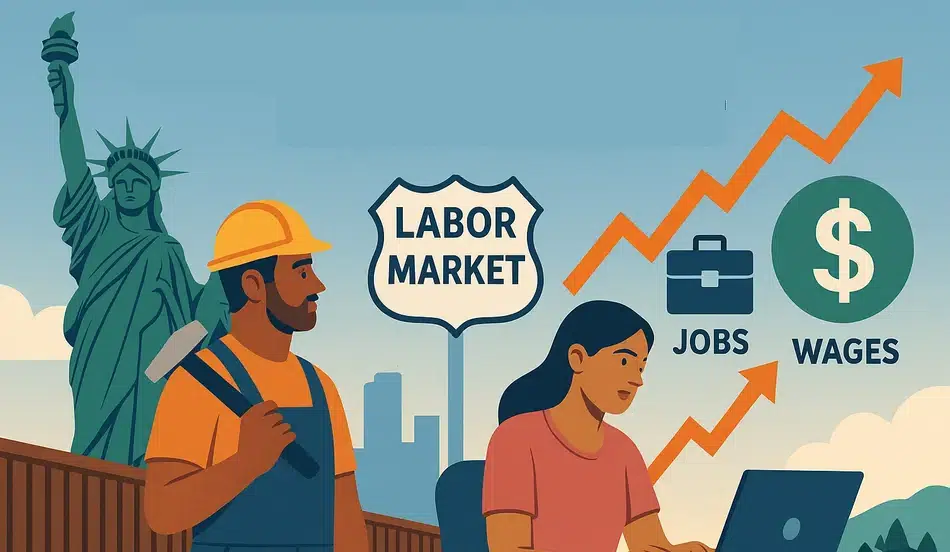Border Security Policies Transform Employment Demographics
The latest employment figures tell a compelling story about the US immigration impact on labor market conditions. With enhanced border security measures in place, employers are increasingly turning to domestic workers to fill positions across various industries.
The Numbers Behind America’s Employment Transformation
Economic data confirms a fundamental realignment in the US immigration impact on labor market dynamics. The dramatic reduction in illegal border crossings has created immediate ripple effects throughout the economy, with businesses adapting their hiring strategies in response.
“It turns out they actually were taking our jobs,” notes journalist and author Bat Gason. “For five years I’ve been making this argument that illegal migrants are undercutting the wages of working-class Americans.”
Debunking the “Jobs Americans Won’t Do” Narrative
One of the most significant revelations in the US immigration impact on labor market data is the collapse of the common narrative that illegal immigrants primarily take jobs Americans refuse to do.
“There’s this narrative on the left that they’re taking jobs that Americans will not do or don’t want to do. And it’s absolute nonsense,” explains Gason. “There’s not a single industry in the United States that’s done by a majority illegal migrant labor. The highest rates are about 30% in agriculture, which means 72% of people working farms are American citizens.”
This data directly contradicts the assertion that certain industries would collapse without illegal immigrant labor. Instead, it suggests that when immigration enforcement increases, Americans readily fill these positions when offered fair compensation.
Real Wage Growth: The Economic Benefit for Working Americans
Perhaps the most significant US immigration impact on labor market outcomes for American workers is the effect on wages. With reduced competition from illegal immigrants willing to work for below-market rates, employers have been forced to raise compensation to attract domestic workers.
“When you have mass deportations and a closed border, employers have to pay more wages. And guess what? Americans are happy to take those jobs,” Gason points out. This wage growth represents real economic improvement for working-class Americans who have struggled with stagnant compensation for decades.
Inflation Concerns Disproven: Tariffs and Immigration Policy
A key economic concern raised by critics of stricter immigration enforcement and trade policies was that these measures would trigger significant inflation. However, recent data has contradicted these predictions.
Economic Experts’ Failed Predictions
“With those increased wages, and we have seen real wages go up, the inflation number has remained low. In fact, it’s fallen,” notes the interview host. “At a time when we were told tariffs were going to see skyrocketing inflation… so much of the economic expertise that we’ve heard from in recent months, in recent years, has come out completely wrong.”
This disconnect between expert predictions and actual outcomes highlights how conventional economic wisdom has failed to accurately assess the US immigration impact on labor market dynamics. The combination of stronger border enforcement and strategic tariffs appears to be benefiting American workers without the predicted inflationary consequences.
Understanding the Real Economic Impact
“Those of us who said from the beginning the tariffs are not going to be inflationary feel pretty good about ourselves,” responds Gason. “He had a theory of the case for how to improve the lives of working-class Americans. And what we’re seeing right now is him just making good again and again and again on that theory.”
This validation of alternative economic approaches suggests that the US immigration impact on labor market outcomes may require a fundamental reassessment of established economic models and assumptions.
The Human Cost of Illegal Immigration: Labor Exploitation
Beyond the macroeconomic statistics, the US immigration impact on labor market conditions has significant humanitarian implications. The interview highlights how illegal immigration creates conditions for worker exploitation that harm both immigrants and American workers.
The Hidden Reality of Exploitative Labor Practices
“The downward mobility of the American working class is due to a number of factors, but the massive increase in illegal labor is one of the biggest ones,” Gason explains. “You look at the 1970s, which is when working-class Americans could really afford to support a family in dignity on a single income, the share of the population that was foreign-born in America was 4%. You look today and it’s over 15%.”
This historical perspective provides context for understanding how the US immigration impact on labor market conditions has evolved over decades, with significant consequences for middle and working-class families.
Who Benefits from Uncontrolled Immigration?
The interview makes a compelling case that the primary beneficiaries of illegal immigration are not average Americans but rather economic elites who consume low-wage services.
“The elites in both parties have been very much enjoying this because they are the consumers of low-wage labor,” notes Gason. “Of course, they would rather pay a nanny $40,000 a year under the table than pay an American $70,000 a year and give them benefits.”
This analysis suggests that the US immigration impact on labor market dynamics has created a system where the economic benefits flow primarily to the wealthy, while the costs—in terms of depressed wages and reduced opportunities—fall disproportionately on working-class Americans.
Legal vs. Illegal Immigration: A Critical Distinction
The discussion emphasizes the importance of distinguishing between legal and illegal immigration when analyzing the US immigration impact on labor market conditions.
The Positive Contribution of Legal Immigrants
Legal immigration continues to provide significant benefits to the American economy, with many legal immigrants becoming entrepreneurs and job creators.
“Legal immigrants often become job creators themselves, establishing businesses that employ American workers,” the discussion highlights. These entrepreneurial contributions demonstrate how properly managed immigration can complement rather than compete with the domestic workforce.
Immigration System Reform Needs
Despite the benefits of legal immigration, the current system faces significant challenges. Bureaucratic delays and inefficiencies in visa processes can prevent valuable contributors from entering the country legally.
“The problem is we are so screwed up with State Department and visa and passports it takes years for good people to come in here,” the discussion notes. These delays harm economic growth by preventing businesses from accessing needed talent and entrepreneurs from establishing job-creating enterprises in the United States.
Hiring? Post Jobs for Free with WhatJobs
Looking to connect with motivated American workers ready to make an impact? Post your job listings for free on WhatJobs and reach qualified candidates seeking stable employment, fair wages, and growth opportunities. Start hiring smarter today.
Post a Job NowThe Path Forward: Balanced Immigration Policies
As the American economy continues to adjust to changing immigration patterns, the data suggests that a balanced approach to immigration enforcement can yield significant benefits for American workers while still allowing for beneficial legal immigration.
Streamlining Legal Immigration Processes
One clear area for improvement is the efficiency of legal immigration processes. Reducing backlogs and streamlining visa applications for qualified immigrants would help businesses access needed skills while maintaining the integrity of the immigration system. This balanced approach would maximize the positive US immigration impact on labor market outcomes while minimizing negative effects.
Investing in American Worker Training
As employers adjust to a changing labor pool, investments in training and workforce development become increasingly important. Programs that help American workers develop skills for in-demand jobs can ease transition challenges and ensure businesses have access to the talent they need. These initiatives represent a proactive response to the US immigration impact on labor market shifts that benefits both workers and employers.
Maintaining Economic Momentum
The current positive trends in employment and wages suggest that the American economy is adapting successfully to the changing labor market dynamics. Continuing policies that support domestic manufacturing, fair wages, and appropriate immigration controls could help maintain this momentum. The US immigration impact on labor market appears to be contributing to an economy that works better for ordinary Americans, a trend worth preserving and strengthening.
FAQ: Understanding the US Immigration Impact on Labor Market
How has enhanced border security affected wages for American workers?
The US immigration impact on labor market wages has been significant, with data showing that American workers are experiencing real wage growth as competition from illegal immigrants willing to work for lower wages has decreased. When border security is enhanced and illegal immigration declines, employers must compete more vigorously for workers, leading to higher wages. This wage effect is most pronounced for lower and middle-income workers who historically faced the most direct competition from illegal immigration. The current data shows that these wage increases are occurring without triggering the inflation that many economists had predicted.
Is it true that Americans won’t do certain jobs that immigrants typically perform?
This common narrative is contradicted by current US immigration impact on labor market data. There is no industry in the United States where illegal immigrant labor constitutes a majority of workers. Even in agriculture, which has the highest concentration of immigrant labor, approximately 70% of workers are American citizens. When employers offer fair wages and reasonable working conditions, Americans have demonstrated willingness to work in all sectors of the economy. The notion that certain jobs are “beneath” Americans appears to be more myth than reality, especially when those positions offer competitive compensation.
How does legal immigration differ from illegal immigration in its economic impact?
Legal and illegal immigration have distinctly different US immigration impact on labor market outcomes. Legal immigrants often become entrepreneurs who create jobs for Americans, pay taxes, and contribute to economic growth in structured, regulated ways. They frequently fill specific skill gaps or create new businesses that complement the existing economy. In contrast, illegal immigration can undermine wages and working conditions by creating an unregulated labor pool willing to work for below-market compensation. A balanced immigration policy would maintain pathways for beneficial legal immigration while reducing illegal border crossings that can negatively impact American workers’ wages and job opportunities.
Who benefits most from illegal immigration in the American economy?
Analysis of the US immigration impact on labor market suggests that the primary beneficiaries of illegal immigration are economic elites who consume low-wage services rather than average Americans. Wealthy individuals and businesses can access cheaper services—from childcare and housekeeping to construction and landscaping—when there’s an abundant supply of undocumented workers willing to accept below-market wages without benefits. Meanwhile, working-class Americans face wage depression and reduced job opportunities due to this competition. This creates a system where the economic benefits of illegal immigration flow primarily to the wealthy, while the costs are borne disproportionately by middle and working-class families.




